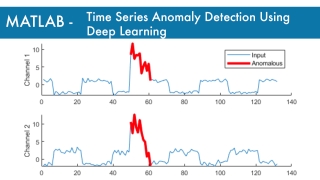
This example shows how to detect anomalies in sequence or time series data.
To detect anomalies or anomalous regions in a collection of sequences or time series data, you can use an autoencoder. An autoencoder is a type of model that is trained to replicate its input by transforming the input to a lower dimensional space (the encoding step) and reconstructing the input from the lower dimensional representation (the decoding step). Training an autoencoder does not require labeled data.
An autoencoder itself does not detect anomalies. Training an autoencoder using only representative data yields a model that can reconstruct its input data by using features learned from the representative data only. To check if an observation is anomalous using an autoencoder, input the observation into the network and measure the error between the original observation and the reconstructed observation. A large error between the original and reconstructed observations indicates that the original observation contains features unrepresentative of the data used to train the autoencoder and is anomalous. By observing the element-wise error between the original and reconstructed sequences, you can identify localized regions of anomalies.

